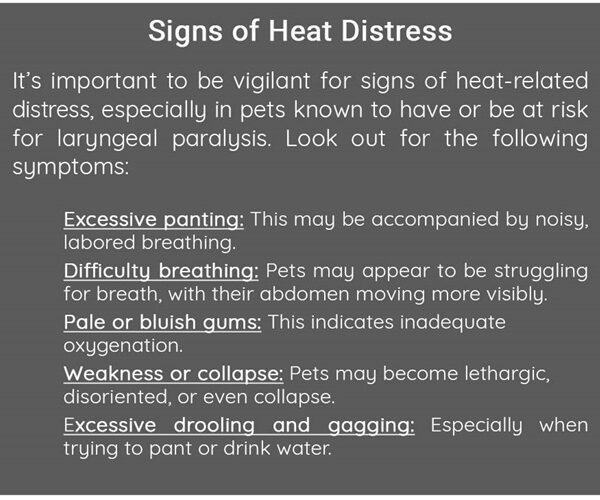
- Pets
- Health
Summer is heating up…keep an eye out for laryngeal paralysis
August 29, 2024
As the temperature rises, so do the risks for pets with laryngeal paralysis. This condition, which affects the ability of the larynx (or voice box) to open and close properly, can pose serious dangers, especially in the hot, humid months of summer. Understanding these risks and knowing how to protect your pet is crucial to keeping them safe.

What is Laryngeal Paralysis
Laryngeal paralysis occurs when the nerves controlling the larynx become damaged or weakened, preventing the larynx from opening properly during breathing. This can lead to restricted airflow, making it difficult for your pet to breathe, especially during exercise or in warm weather. While laryngeal paralysis can affect any dog, it is most commonly seen in older, large-breed dogs like Labrador Retrievers and Golden Retrievers.

Why Summer Is Especially Risky
During the summer, pets are more prone to overheating due to the increased temperature and humidity. For pets with laryngeal paralysis, this is particularly dangerous because their compromised airway function makes it difficult for them to cool down effectively. The larynx, which should open wide to allow for heavy breathing and panting, doesn’t function properly, leading to decreased airflow and a higher risk of overheating and respiratory distress.
Even a short time outdoors on a hot day can be enough to trigger an emergency in a pet with laryngeal paralysis. The combination of heat, exercise, and excitement can overwhelm their already compromised respiratory system, leading to a life-threatening situation.
Preventing an Emergency
To prevent an emergency, take these steps to protect your pet during the summer:
1. Limit outdoor activity: Keep your pet indoors during the hottest parts of the day, usually from late morning to early evening. If they need to go outside, do so in the early morning or late evening when temperatures are cooler.
2. Use a harness instead of a collar: A harness reduces pressure on the neck and larynx, making breathing easier.
3. Provide a cool environment: Ensure your pet has access to air conditioning or fans and plenty of fresh, cool water.
4. Avoid stressful situations: Keep your pet calm and avoid overly stimulating activities that can cause excitement or anxiety, both of which can exacerbate breathing difficulties.
5. Monitor closely during walks: Shorten walks, keep them at a slow pace, and watch for any signs of distress. If your pet starts to pant heavily or show signs of discomfort, it’s time to head indoors.
6. Know your emergency options: Be aware of the nearest veterinary clinic and emergency services. If your pet shows signs of respiratory distress, seek veterinary attention immediately.

When to Seek Emergency Help
If your pet shows any signs of heat-related distress or respiratory difficulty, contact your veterinarian immediately. Early intervention is critical in preventing a minor issue from becoming a life-threatening emergency. There are surgical options to prevent dogs with laryngeal paralysis from developing a life-threatening respiratory crisis; these procedures are offered at VSC! More information about the surgery can be found here: Laryngeal Paralysis
Laryngeal paralysis can be a serious condition, especially during the summer months when the risks are heightened. By taking proactive steps to manage your pet’s environment and monitoring them closely, you can help prevent an emergency and keep your furry friend safe and comfortable all summer long.